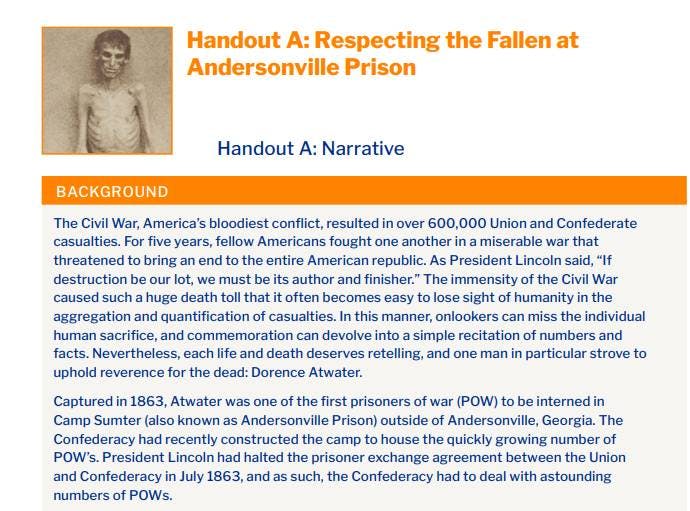Respecting the Fallen at Andersonville Prison – Handout A: Narrative
BACKGROUND
The Civil War, America’s bloodiest conflict, resulted in over 600,000 Union and Confederate casualties. For five years, fellow Americans fought one another in a miserable war that threatened to bring an end to the entire American republic. As President Lincoln said, “If destruction be our lot, we must be its author and finisher.” The immensity of the Civil War caused such a huge death toll that it often becomes easy to lose sight of humanity in the aggregation and quantification of casualties. In this manner, onlookers can miss the individual human sacrifice, and commemoration can devolve into a simple recitation of numbers and facts. Nevertheless, each life and death deserves retelling, and one man in particular strove to uphold reverence for the dead: Dorence Atwater.
Captured in 1863, Atwater was one of the first prisoners of war (POW) to be interned in Camp Sumter (also known as Andersonville Prison) outside of Andersonville, Georgia. The Confederacy had recently constructed the camp to house the quickly growing number of POW’s. President Lincoln had halted the prisoner exchange agreement between the Union and Confederacy in July 1863, and as such, the Confederacy had to deal with astounding numbers of POWs.
Built to house approximately 10,000 prisoners, Andersonville remained consistently overpopulated; the overcrowding reached its climax in 1864 with a population of almost 32,000. If Camp Sumter were a city, it would have been the fifth most populous urban center in the Confederate States. Prisoners arrived at the camp at an average of 400 per day. These are the circumstances in which Dorence Atwater demonstrated a deep respect for both the lives and deaths of his fellow prisoners at Andersonville.
NARRATIVE
The cold winter day chilled the prisoners to the bone as they disembarked from the steam locomotive. These few hundred men were the first to reach the newly built Camp Sumter; they came mostly from the prison at Richmond. “Nothing can be worse than Richmond,” they thought. Unfortunately, they were wrong. At first, Camp Sumter provided adequate space, but as the prison population grew, the situation became desperate. Every day, 400 more men arrived at the gates of the still-growing camp. Few actual buildings existed, and the Confederate guards used most of these for themselves. The prisoners inside the camp used scraps of wood and cloth to create shanties which they called “shebangs.” Furthermore, the Confederates lacked adequate supplies to feed the prisoners properly. The Southern states viewed POW’s as “incidental” concerns: the faltering Confederacy funneled food, clothing, and other resources to the army rather than the Northern prisoners.
The combination of overcrowding, malnutrition, and putrid living conditions led to the highest death rate of any POW camp in the Civil War. The inmates called Andersonville “Hell itself,” and with good reason. Over its existence, 45,000 POW’s passed through Camp Sumter, and of these almost 13,000 men died. It housed about 10 percent of the total POW population during the Civil War, yet it generated 23% of the deaths. The situation was so deplorable that a prisoner died, on average, every eleven minutes. Anderson ville’s commanding officer, Captain Henry Wirz, struggled to adequately provide for the prisoners, but his repeated requests for aid went unheeded by Confederate leaders. Squalor, disease, and death ensued.
Dorence Atwater, a Union prisoner of war who had been captured after the Battle of Gettysburg, came to Andersonville shortly after it opened. Because of the high mortality rate, Captain Wirz tasked Atwater with keeping an official record of deaths and the locations of prisoner burials. Knowing that he would most likely be deprived of this list when the war ended, Atwater made his own copy. This list grew immensely and supposedly became so large that it could not be folded in two. His list became the Andersonville book of death. Atwater kept his log diligently, recording the dates of death, names, and burial places of everyone who died in captivity. Though he could do little to alleviate the suffering that surrounded him, Atwater did all in his power to recognize and remember the Union soldiers who died.
By September 1864, Union General Sherman and his army came within striking distance of Andersonville. On his release from prison, Atwater smuggled out the death list by hiding it in a cotton sack full of laundry. Returning to the North, he met Clara Barton, the famous nurse, and founder of the American Red Cross. He then began a mission back to Andersonville to mark the graves of prisoners. At the end of the mission, Atwater kept the list that the government now claimed to own. He was court-martialed, convicted of theft, and thrown in federal prison. Fortunately, Barton came to his aid and secured a presidential pardon.
With the help of Barton, Dorence Atwater marked all but 460 graves. Through the enduring misery and hardship of his captivity, Atwater dutifully maintained his macabre log to honor those who had fallen. Did Atwater do this simply because he was ordered to by Captain Wirz? Certainly not; Atwater knew that the lives and deaths of the thousands who perished at Andersonville deserved remembrance. Atwater strove to preserve the dignity of his comrades in the best way he could. His legacy is not just his own—the life and death of every man who died at Andersonville make up a part of his endowment to American history.
